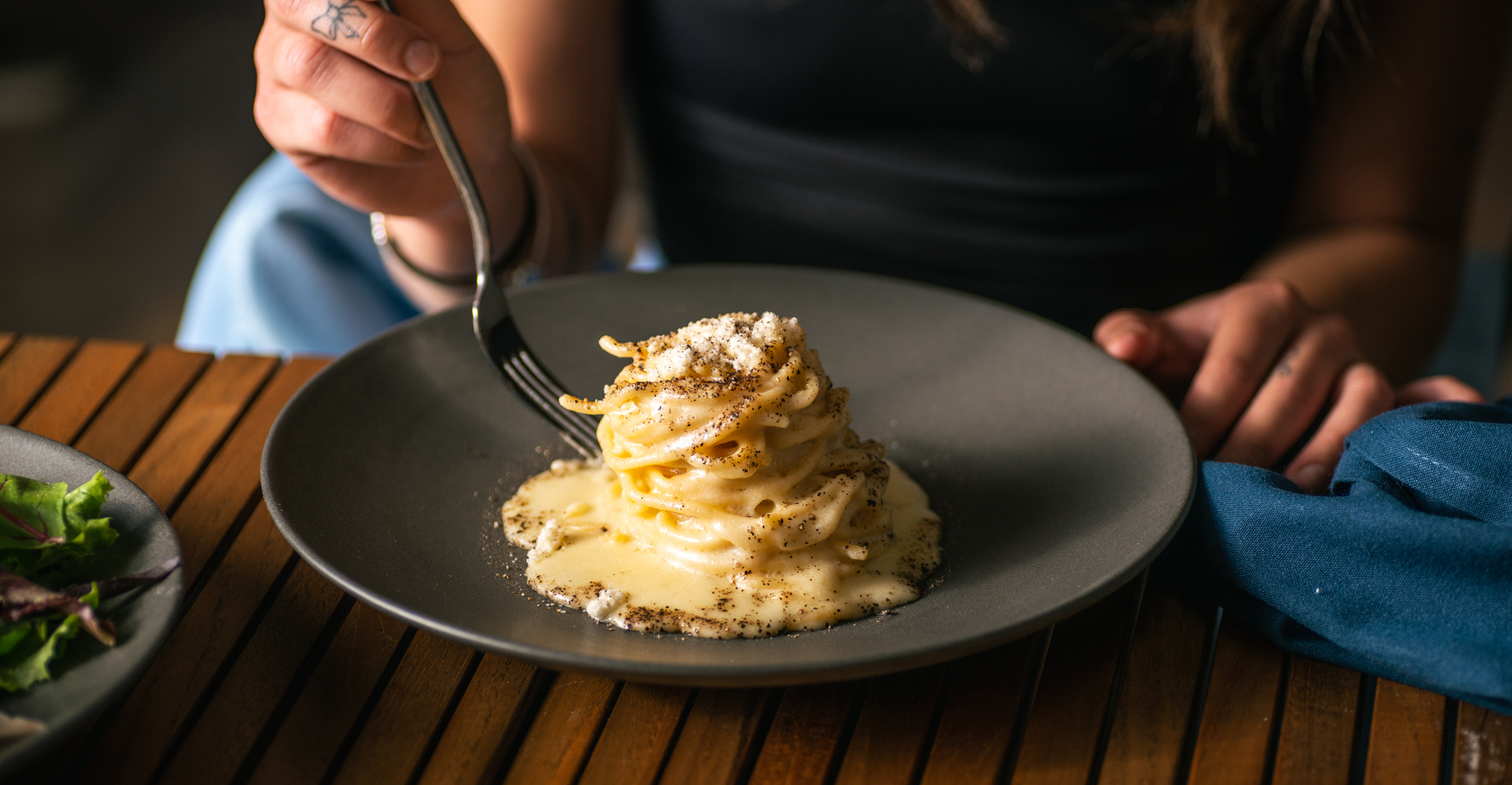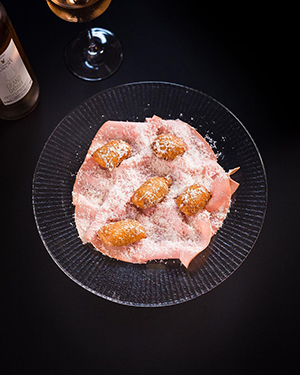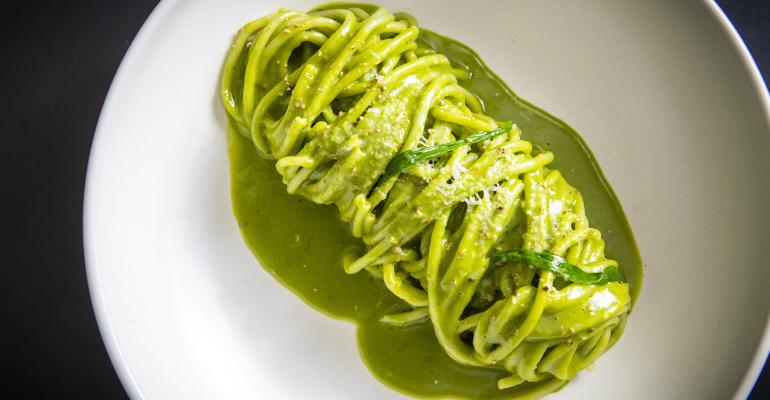Not too long ago, cacio e pepe was a rather obscure pasta dish in the U.S. The simple preparation of long thin noodles, such as spaghetti or bucatini, traditionally spun with a little pasta water in a partially hollowed out wheel of pecorino Romano cheese and then seasoned with black pepper, took a backseat to more unctuous options, such as rich carbonara with its egg yolks and guanciale, or meatier ones such Bolognese, or of course the Italian-American spaghetti and meatballs.
But the dish whose name simply means “cheese and pepper” has been spreading on menus quite rapidly in recent years. It was on 48% more menus at the end of 2022 than it was four years earlier, according to menu research firm Datassential. In fact, it is becoming so widespread that the rich, slightly sweet and mildly spicy flavor is being used in preparations well outside of pasta — as a spread, on flatbread, and elsewhere.
“Cacio e pepe is an extremely simple dish,” said Stefano Terzi, chef and owner of ViceVersa restaurant in New York City, where he makes a traditional version using tonnarelli pasta. “It’s not only very simple, but a very old dish that the farmers [in the region of Lazio, where Rome is located] used to make in the middle of the fields in the summer when they had one pot with water and the cheese and black pepper. It’s a beautiful dish when you use the right ingredients.”
Terzi uses Scorza Nera, a type of pecorino Romano distinguished by the fact that its rind is painted black. “It tastes better and is slightly less salty” than other pecorino Romano varieties, Terzi said.
He also uses Ceylon black pepper, which he says is more aromatic and less spicy than other pepper varieties.
“I am very careful to use the right ingredients, and that’s it,” he said.
Others are less purist. Although pecorino Romano is a sheep milk cheese, another hard cheese that’s easily grated, the cow-milk Parmigiano Reggiano, is often used as a substitute in American restaurants.
At L’antica Pizzeria da Michele, an outpost of a 150-year-old restaurant in Naples, Italy, that opened in New York in December, executive chef Michele Rubini uses traditional pecorino Romano, but adds Parmesan rind water as well.
The Cacio e Pepe at L’antica Pizzeria da Michele.
“We respect the origins of the dish, but add our own twist … which adds a richer and cheesier flavor,” he said.
Patrick Balcom, chef of Farow restaurant in Niwot, Colo., said it was actually Massimo Bottura of Osteria Francescana in Modena — located in Emilia-Romagna, where Parmigiano Reggiano comes from, and not Lazio — who helped bring attention to cacio e pepe in the U.S., and he did it to help promote his region’s most famous cheese.
“Massimo Bottura pushed [cacio e pepe] hard when the Parma region was hit with a bad earthquake in 2012,” Balcom said. And indeed Balcom uses Parmigiano Reggiano along with a semi-soft Roman sheep’s milk cheese called Cacio de Roma in his low-carbohydrate version of cacio e pepe, for which he uses spiralized rutabaga instead of pasta.
Yury Krasilovsky, executive chef for foodservice research and development for pasta supplier Barilla America, said cacio e pepe’s simplicity and authenticity are part of its appeal.
“The bite of black pepper is spicy enough to be interesting, but not enough to be polarizing,” he said.
“There are some theories that cacio e pepe is an early ancestor to mac ’n’ cheese,” he added. “It certainly shares some of the cheesy, savory indulgence that makes mac ’n’ cheese the most popular pasta dish in America.”
The traditional preparation, with the cheese wheel, can be tricky, he said. It requires a bit of finesse and has to be made à la minute, right before it’s served. “But with a really light Alfredo sauce, you get something more forgiving,” he said.
There are also ways to bring local and seasonal flair to the dish. Krasilovsky said arugula is a nice addition because it has a pepperiness of its own, but truffles, mushrooms, and roasted winter squash in the cooler months, and summer squash or corn in warmer weather, can also work well. “Aromatic herbs are always a good call, too,” he said.
Last year, Andy Quinn, chef of The Noortwyck in New York City, made a pesto out of ramp greens and mixed that with house-made cultured butter. He added that along with pecorino Romano to house-made bucatini and finished the dish with fermented white peppercorns from the Indonesian island of Bangka that he said added “a deep umami flavor and funk to everything they touch.”
“The inspiration for the dish is a classic Roman pasta, but [I’m] using a great local ingredient and fermented white pepper instead of the classic black pepper,” he said at the time.
 Photo: The Cacio e Pepe Zeppole at Grandmaster Recorders.
Photo: The Cacio e Pepe Zeppole at Grandmaster Recorders.
Blake Shailes, head chef of Grandmaster Recorders, a restaurant in a former recording studio in Los Angeles, said the reason for cacio e pepe’s popularity is simple.
“It’s just super delicious,” he said “Pecorino and black pepper: You can’t really go wrong with it, and in the pasta form it’s creamy, a little bit spicy, salty — it’s all the things that people love.”
Shailes makes Cacio e Pepe Zeppole; he takes the light and fluffy fried dough balls and then coats them with grated pecorino Romano and black pepper, and serves them on a bed of finely shaved mortadella, which guests are meant to pick up and wrap around the hot zeppole so the fat in the meat melts a little.
“You get that nice, salty, peppery, crispy bite with mortadella. It’s quite delightful,” he said. It’s also a crowd favorite, he added.
Other variations abound. Bergamo’s, a cocktail lounge near Grand Central Terminal in New York City, has a cacio e pepe dip as a bar snack, made by blending grated pecorino Romano with toasted, coarsely ground pepper and cream cheese thinned out with a little whole milk. It’s served with the Sardinian flatbread carta di musica.
Wolfgang Puck reportedly served cacio e pepe at the Oscars Governors Ball last year as a form of mac ’n’ cheese mixed with green, pink, and black peppercorns and a blend of Parmesan cheese and aged white cheddar.
And at The Cheesecake Factory, the flavors are used as a flatbread, which is topped with both Romano and Parmesan cheeses, “and lots of freshly ground black pepper,” according to the menu.





